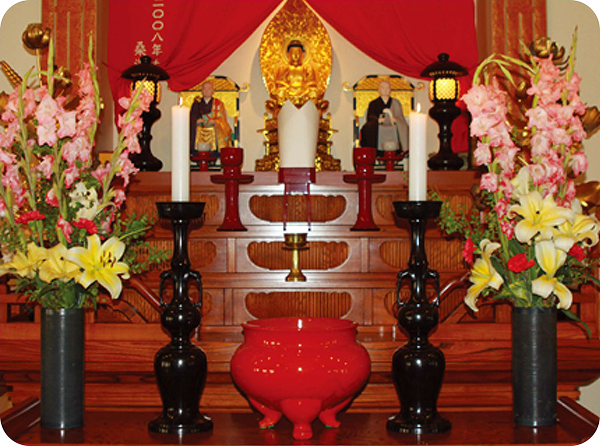Use of Cookies
Our website uses cookies to facilitate and improve your online experience.
The main hall of a regular temple is a place where the statues of the Buddha, Tathagatas, or Bodhisattvas are enshrined. This hall functions both as the Buddha hall and the Dharma hall. The Buddha hall is the place where the statue of Buddha is enshrined while the Dharma hall is the place where priests preach Dharma. Temples of the Zen school originally had no Buddha hall and only a Dharma hall was built. Later on, however, a Buddha hall was added in the monastery complex in front of the Dharma hall. Still later, the Buddha hall and the Dharma hall were combined and this was called the Hondo, the main hall. This development can be said to be something originally Japanese. The main hall is the most important place of faith and practice for Buddhists. This is where chanting and preaching takes place as well as services are conducted to show our gratitude to Buddha. These services include the celebration of Buddha's Birth and Enlightenment and the commemoration of Pari-nirvana as well as memorial services for the ancestral masters.
The Main hall is the heart of the temple. This is where the peoples' hearts are rooted.

The altar located in the central front part of the main hall where the main statue of Buddha is enshrined is called Shumidan, or "altar of Sumeru." In Buddhist mythology, the Buddha is believed to preach from on top of Mt. Sumeru. Mt. Sumeru is considered a sacred mountain in the ancient Indian cosmology and this sacred mountain is expressed as an altar with various decorations. Although the elevated part of the altar is considered to be the sacred world where people are prohibited to step in, there are some occasions where the leaders of sanghas preach Dharma on Buddha's behalf. The majestic way the resident priest preaches Dharma there is respectfully described as "Shishiku, Lion's Roar."
There are pairs of both flowers and candles and an incense burner either on or in front of the altar of Sumeru. This set of ornaments are called Gogusoku, the Five Adornments. The flowers offered in the vases adorn Buddha's seat, the light of the candles is considered to be Buddha's eyes and his teachings, and the incense is offered as Buddha's meal. However, if there is not enough space for the five adornments, it is sufficient to place a single flower vase, candlestick and incense burner on the altar. These are called Three Adornments. With three adornments, we place the candlestick on the right, the flower vase on the left, and the incense burner in the center.
In addition to the Five Adornments, a pair of Joka or eternal flowers adorn the altar. They are made of wood and colored in either gold or different colors and designed in the shape of lotus flowers.
Joka expresses the flowers that never wither in the Pure Land. They also signify the eternal continuity of the Buddha dharma.
Tengai is an adornment in the shape of a canopy hanging from the central part of the ceiling in the main hall. This ornament originates from the shape of the parasol used in India to create shade for the royal family that was held by their servants. This custom was introduced to Buddhism and the story of Sakra, the guardian diety of Buddhism who always held a parasol for Buddha, was created. Tengai hanging above the priest who leads the other practitioners and followers is an expression of the followers’ deep respect for the priest and the priest's virtue. At the same time, Tengai encourages all those who surround the leader and his followers to continue their virtuous conduct and seek for the deeper realm of enlightenment so that they too will be able to sit under Tengai.
As mentioned already, Buddhist ornaments in the hall are expressions of abstract phenomena including ancient Buddhist cosmology, teachings of Buddhadharma and the sincerity, respect and vows of the followers and practitioners who encounter the Dharma.
